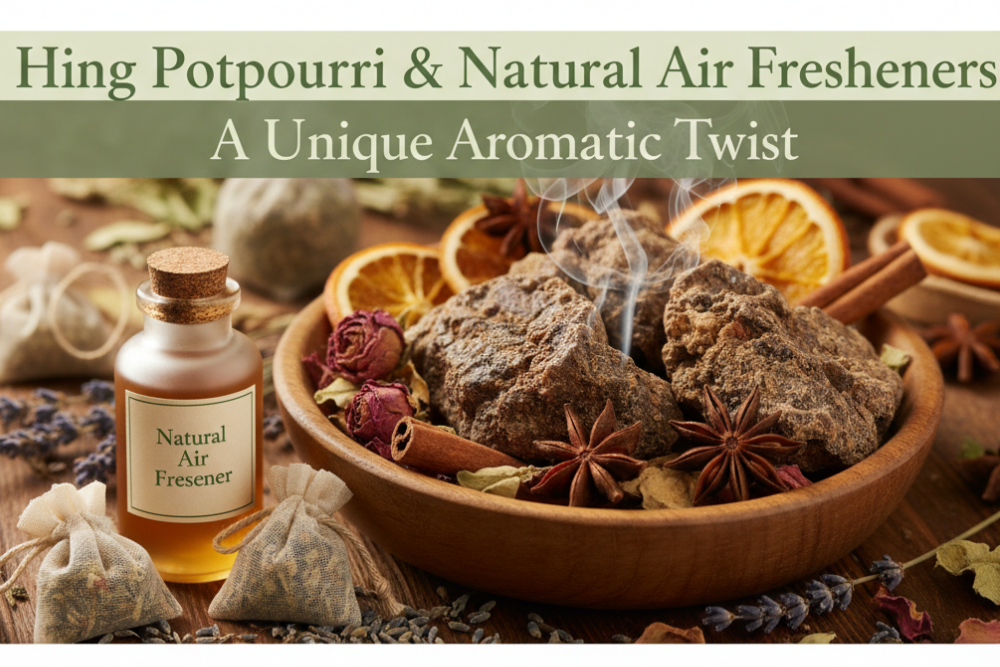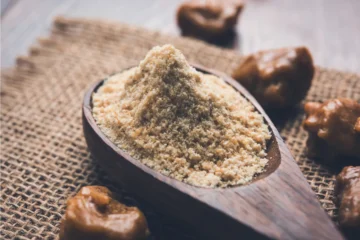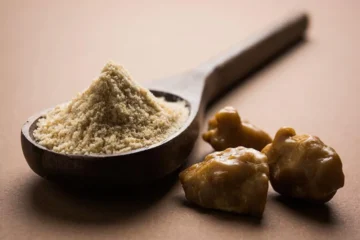Looking for a chemical-free way to refresh your home? Hing natural air freshener made with potpourri offers a surprising, earthy aroma that neutralises odours while adding a unique Indian touch. Below are commonly asked questions and detailed answers to help you create and enjoy this aromatic twist in your home.
Can hing really be used as an air freshener — won’t its smell be too strong or pungent indoors?
Short Answer (under 50 words): Yes, hing can be used as a natural air freshener when balanced with herbs, citrus peels, or essential oils. Its strong scent mellows into a warm, earthy aroma that neutralises unpleasant odours without overpowering your living space.
Detailed Answer:
- Aroma Transformation: When mixed with dried flowers, citrus peels, or lavender, hing’s initial pungency softens into a subtle, earthy fragrance.
- Odour Neutralisation: Hing naturally absorbs and neutralises strong kitchen or pet odours.
- Balanced Blends: Combining hing with sweet-smelling ingredients like rose petals or orange peels ensures a pleasant and inviting scent.
- Cultural Tradition: For centuries, Indian households have used hing in rituals and for purifying indoor air.
What are the benefits of using hing-based potpourri — does it help with allergies, digestion, or mood?
Short Answer (under 50 words): A Hing natural air freshener provides antimicrobial and air-purifying benefits. It may help reduce airborne allergens, support respiratory comfort, and create a calming, earthy environment that uplifts mood naturally.
Detailed Answer:
- Air Purification: Hing contains natural antimicrobial compounds that help reduce bacteria and indoor toxins.
- Respiratory Comfort: Its earthy aroma can ease mild nasal congestion and support cleaner breathing.
- Mood Enhancement: The subtle scent of hing combined with citrus or floral notes promotes relaxation and stress relief.
- Traditional Wellness: Ayurvedic practices value hing for its ability to balance the environment and improve overall energy flow.
- Allergy Support: Regular use of hing potpourri may help lower the presence of allergens in indoor air, making it ideal for sensitive individuals.
How do I make hing potpourri or a natural air freshener at home — what ingredients pair well with it?
Short Answer (under 50 words): Combine dried flowers, orange peels, ajwain seeds, cloves, and a pinch of hing to create a Hing natural air freshener. Add a few drops of essential oils like lavender or lemon for a balanced fragrance that refreshes any space.
Detailed Answer:
- Ingredients Needed:
Ingredient Quantity Purpose Dried rose petals 1 cup Adds floral sweetness Orange peels (dried) ½ cup Provides fresh citrus notes Ajwain seeds 2 tbsp Enhances earthy aroma Cloves 1 tbsp Adds warm spice notes Hing powder ¼ tsp Acts as a natural deodoriser Lavender or lemon essential oil 3–5 drops Balances fragrance - Step-by-Step Method:
- Dry all ingredients thoroughly to prevent mould.
- Mix rose petals, orange peels, ajwain seeds, and cloves in a bowl.
- Add ¼ tsp of hing powder and a few drops of essential oil.
- Store in a decorative glass jar or breathable cotton pouch.
- Place in living rooms, closets, or bathrooms for long-lasting freshness.
- Tip: Shake the jar every few days to refresh the scent naturally.
Is hing potpourri safe for kids, pets, or people with asthma — are there any precautions I should take?
Short Answer (under 50 words): Hing potpourri is generally safe but requires caution. Keep it out of reach of kids and pets, ensure good ventilation, and test for sensitivity in people with asthma by using a small amount first.
Detailed Answer:
- Keep Out of Reach: Store the potpourri in high places where children or pets cannot access it.
- Ventilation: Place it in well-ventilated areas to avoid overwhelming sensitive noses.
- Allergy Testing: If anyone has asthma or respiratory issues, test with a small quantity first.
- Avoid Direct Contact: Hing can be strong if touched or ingested; use decorative jars with lids or breathable pouches.
- Use Minimal Hing: A small pinch is enough to create aroma without causing discomfort.
How does hing compare to chemical air fresheners — is it more effective or just a natural alternative?
Short Answer (under 50 words): Hing natural air freshener is a healthier alternative to chemical sprays. While its scent is subtler, it purifies air naturally, avoids synthetic toxins, and reduces environmental impact compared to commercial air fresheners.
Detailed Answer:
- Health Benefits: Hing contains no artificial chemicals or synthetic fragrances, reducing exposure to harmful VOCs (volatile organic compounds).
- Eco-Friendly: Unlike chemical sprays, hing potpourri is biodegradable and sustainable.
- Cost-Effective: Ingredients are inexpensive and last longer when refreshed with essential oils.
- Natural Aroma: Provides a mild, earthy fragrance compared to the sometimes overpowering synthetic scents of sprays.
- Long-Term Impact: Helps maintain indoor air quality without adding pollutants to the environment.
Conclusion
Hing natural air freshener potpourri is a simple yet powerful way to refresh your home naturally. By blending hing with citrus, flowers, and herbs, you create a unique, earthy aroma that purifies air and promotes wellness. It’s safe, eco-friendly, and an excellent alternative to chemical air fresheners.





